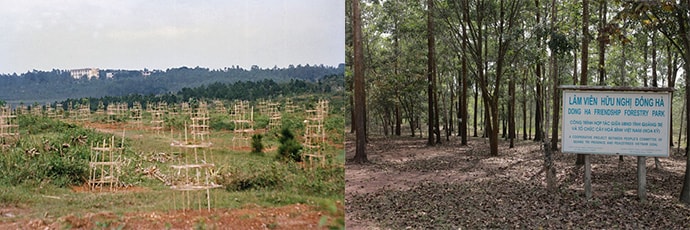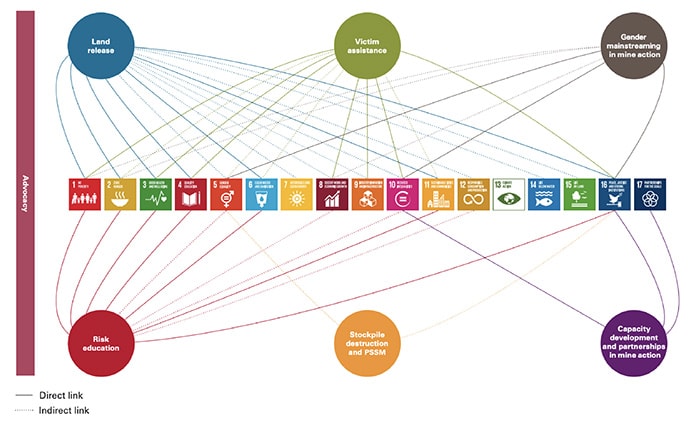By Carlie Stowe, Project Manager, PeaceTrees Vietnam

PeaceTrees Explosive Ordnance Disposal (EOD) Technician, Phan Thị Ngọc, working to clear land of explosive ordnance in Quang Tri Province, Vietnam
Russia’s invasion of Ukraine and the indiscriminate use of deadly weapons of war, including cluster munitions and other explosive remnants of war (ERW), is showcasing, in real-time, the devastation that war brings to a country and the terrible reality of the use of explosive ordnance. Across the globe, ERW threaten people’s lives and livelihoods every day. In 2020, 7,073 casualties due to landmines and other ERW were recorded across 56 states (and other non-state territories). In addition to the physical threat they pose to people’s lives, the presence of explosive ordnance blocks access to critical resources like clean water and farmland, and hinders social and economic development opportunities, further perpetuating poverty rooted in the impact of war.
PeaceTrees Vietnam knows the devastation that war brings to a country and its long-lasting impacts on the health, safety, and prosperity of all people. PeaceTrees works every day to clean up deadly explosive remnants of a war that ended nearly 46 years ago.
Over the past 26 years, and in partnership with communities and provincial leadership, PeaceTrees has worked to support sustainable and prosperous futures for people in central Vietnam. Through our mine action program, PeaceTrees deminers have returned over 4,712 acres of safe land to communities and have found and destroyed over 136,000 ERW. They have also educated over 289,000 people on the risks of explosive ordnance through PeaceTrees explosive ordnance risk education (EORE) program. In addition to restoring safety to war-impacted communities, this work has been a necessary precursor for the social and economic development of the province. Without access to safe land, farmers are prevented from safely tending to their land, children are put in danger on their walks to and from school, and other NGOs and community-led organizations are unable to safely deliver their services.

Left: Trees planted on safely cleared land in 1996 in Dong Ha Town, Quang Tri Province, Vietnam; Right: The same trees in 2021, at what is now known as Dong Ha Friendship Forestry Park, Quang Tri Province, Vietnam. Peace Trees EOD technicians removed 50 items of explosive ordnance from this plot of land that is now used by children and families as a common place to picnic, play, and enjoy nature.
Today (April 4th) is International Day for Mine Awareness and Assistance in Mine Action (IMAD). This day aims to bring awareness to the ongoing threat posed by mines and other explosive bombs, grenades, and munitions across the globe, and to mobilize political will and resources needed to address this deadly issue. The objective of mine action is to identify and reduce the impact and risk of explosive hazards to a level where people are safe. Land clearance, EORE, victim assistance (referred to here as survivor assistance), advocacy, and stockpile destruction comprise the core activities of the mine action sector.
Mine action is about creating new opportunities for access and development. It is not only a needed precursor for sustainable development, but it is also intimately linked to the 17 SDGs. Fragile, conflict, and war-affected states are the furthest away from achieving the SDGs. Ensuring that no one is left behind requires acknowledging the interconnected nature of humanitarian action, development, and peacebuilding. In war-impacted states, addressing ERW through mine action is at the heart of this nexus, and often foundational to humanitarian, development, and peacebuilding programs that follow a war’s end. We want to highlight how mine action helps to enable the SDGs and supports the important work of many GlobalWA members.
Linking Mine Action to the SDGs:

Direct (mine action results considered to have immediate effect on SDG) and indirect (mine action outcomes that contribute to the SDG targets in the medium and long term) mine action linkages to the SDGs (Source: GICHD-UN)
As illustrated in the infographic above, mine action contributes directly and indirectly to nearly all the SDGs. While some of these connections are obvious, such as a direct link to SDG 16 (Peace, Justice, and Strong Institutions), other linkages are worth describing given their role in supporting wider humanitarian, peacebuilding, and development work.
PeaceTrees’ work in land clearance and release permits safe agricultural development, supporting communities in their goals for food security and economic self-sufficiency (SDG 2 – Zero Hunger). Additionally, it enables economic growth, productivity, and sustainable tourism practices (SDG 8- Decent Work and Economic Growth).
Land clearance and release also helps to enable the immediate and long-term safety of communities that are experiencing the joint impacts of war legacy and climate change (SDG 13 – Climate Change). Access to safe land is needed to adapt to climate change and prepare for extreme weather-related disasters. Sustainable mine action practices release land that can then be used for disaster risk reduction initiatives and programs aimed at climate change adaptation (SDG 17 – Partnership for the Goals). This work also helps to ensure equal distribution of resource use and sustainable patterns of consumption, as a responsible use and consumption is only possible if resources can be accessed safely (SDG 12 – Responsible Consumption and Production).
Explosive ordnance risk education, which aims to reduce the risk of injury and death from explosive ordnance, is a necessary component for achieving SDG 3 (Good Health and Wellbeing). In 2019, there were at least 1,643 child casualties of ERW worldwide, accounting for 43% of civilian casualties for whom the age group was known (3,850)[1]. EORE plays a crucial role in ending preventable deaths of newborns and children under the age of five, which is target 2 of SDG 3.
Additionally, as an essential component of mine action work, survivor assistance helps provide healthcare, educational opportunities, and economic support for people with disabilities (PWD). This component of mine action works to create inclusion and opportunities for PWD and their families by creating programs that help people obtain and maintain decent work and economic stability (SDG 10 – Reduced Inequalities; SDG 8- Decent Work and Economic Growth). Further, survivor assistance helps amplify the voices of youth, women, and PWD in decision making, ultimately promoting peaceful and inclusive societies for sustainable development and accountable and inclusive institutions (SDG 16 – Peace, Justice, and Strong Institutions).
On this day of International Mine Awareness and Assistance in Mine Action, and as we all work together to achieve the SDGs, we hope that you will bring awareness to your circles about the critical importance of this issue.
Interested in learning more about mine action or explosive ordnance issues in your program country? Please contact PeaceTrees Vietnam: info@peacetreesvietnam.org
Hear from PeaceTrees EOD technician Nguyen Quyen on why she has dedicated her career to creating safe land. (YouTube video)
[1] http://www.the-monitor.org/media/3194714/Impact-of-Mine-ERW-on-Children.pdf